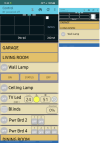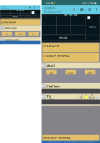I have a Galaxy Z Flip 5 and found the issue with scaling.
The phone has to screens - main an cover screen.
Main Screen: 6.7 inches, Resolution 1080 x 2640 pixels (~425 ppi density)
Cover display: 3.4 inches, Resolution 720 x 748 pixels, 306 ppi
The application uses 2 CLVs and the issue is like this:
When I install application (or run for the firs time after restart) with the phone closed, the application looks fine on the cover screen. But after opening the phone, the app on the main screen is not scaled correctly - see attached picture capture1.png
And the opposite thing happens when install application (or run for the firs time after restart) with the phone open. On the main screen everything looks OK, but when I close the phone and start application on cover screen - it is not scaled correctly - see second picture capture2.png.
It looks like the application keeps the screen density from the first opened screen on the second screen.
I tried different things, using even Activity.finish but this doesn't change anything
Any suggestions how to fix this are welcomed.
The phone has to screens - main an cover screen.
Main Screen: 6.7 inches, Resolution 1080 x 2640 pixels (~425 ppi density)
Cover display: 3.4 inches, Resolution 720 x 748 pixels, 306 ppi
The application uses 2 CLVs and the issue is like this:
When I install application (or run for the firs time after restart) with the phone closed, the application looks fine on the cover screen. But after opening the phone, the app on the main screen is not scaled correctly - see attached picture capture1.png
And the opposite thing happens when install application (or run for the firs time after restart) with the phone open. On the main screen everything looks OK, but when I close the phone and start application on cover screen - it is not scaled correctly - see second picture capture2.png.
It looks like the application keeps the screen density from the first opened screen on the second screen.
I tried different things, using even Activity.finish but this doesn't change anything
Any suggestions how to fix this are welcomed.


